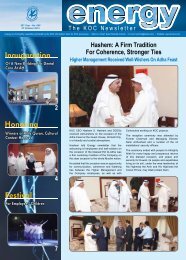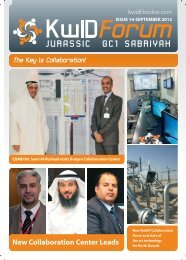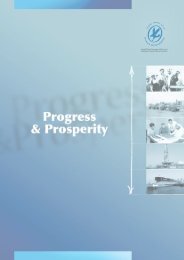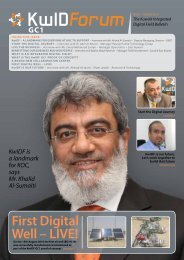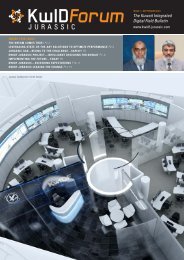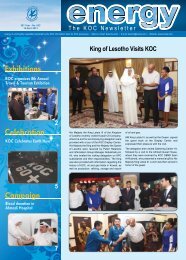4 - Kuwait Oil Company
4 - Kuwait Oil Company
4 - Kuwait Oil Company
Create successful ePaper yourself
Turn your PDF publications into a flip-book with our unique Google optimized e-Paper software.
nanoscale photonic circuits, as existing mechanisms for controlling the flow of light are bulkier and require moreenergy than their electronic analogs.The research team began by precisely cutting a gap into a nanowire. Theythen pumped enough energy into the first nanowire segment that it began to emit laser light from its end andthrough the gap. Because the researchers started with a single nanowire, the two segment ends were perfectlymatched, allowing the second segment to efficiently absorb and transmit the light down its length.Nanoparticles Restore Blood FlowAfter Brain InjuryFollowing a traumatic head injury, a cascade of secondaryproblems can occur. Cells start to release excessive amounts ofa toxic free radical, superoxide (SO), into the blood. It causesinflammation and overwhelms the brain’s natural defenses.Limiting the amount of SO after brain injury is key to effectiveemergency treatment and full recovery of trauma patients. Onthis premise, US researchers from Rice University and BaylorCollege of Medicine have developed carbon nanoparticlesthat are capable of immediately destroying thousands of SOmolecules at once. This is a major medical breakthroughconsidering our body’s natural SO neutralizer, superoxidedismutase (SOD), can interact with just one SO molecule ata time. The nanoparticles developed by the researchers arecalled combined polyethylene glycol-hydrophilic carbonclusters (PEG-HCC). They are known antioxidants because ofthe way they interact with free radicals and are already being tested to enhance cancer treatment. They have alsobeen shown to restore cerebral blood flow in animal studies of brain trauma. The researchers have repeated the teststhree times and obtained the same results. They plan on getting another laboratory to replicate the study to show thatneurological function is definitely improved following the treatment. In future studies they hope to devise a methodof getting the nanoparticles to target specific cell types that are affected after trauma and also hope to elucidate theprecise mechanism of action of these promising carbon compounds.Voyager 1 Soon To Be First Man-MadeObject to Leave the Solar SystemThirty-five years ago, NASA launched a spacecraft known asVoyager 1 into the skies over Florida. That space-travelingappliance has now traveled farther than any other man-madedevice - some 11.3 billion miles or 121 times the distancebetween Earth and the sun. It is now hurtling through theboundary of our heliosphere (the farthest reaches of our sun'swinds) at a speed of 38,000 miles per hour. Soon, nobodyquite knows when, it will break into interstellar space, the firstcreation of life here on Earth to do so. Less than two weeksafter Voyager 1 launched in 1977, it was already 7.25 millionmiles away. (The moon, for comparison, is just 238,900 milesfrom Earth.) When NASA's Voyager 1 and Voyager 2 firstrocketed out of Earth's grip in 1977, no one knew how longthey would live. Now, they are the longest-operating spacecraftin history and the most distant, at billions of miles from Earth but in different directions. Cameras aboard theVoyagers were turned off long ago. The nuclear-powered spacecraft, about the size of a subcompact car, still havefive instruments to study magnetic fields, cosmic rays and charged particles from the sun known as solar wind. Theyalso carry gold-plated discs containing multilingual greetings, music and pictures - in the off-chance that intelligentspecies come across them. Since 2004, Voyager 1 has been exploring a region in the bubble at the solar system'sedge where the solar wind dramatically slows and heats up. Over the last several months, scientists have seenchanges that suggest Voyager 1 is on the verge of crossing over. When it does, it will be the first spacecraft to explorebetween the stars. Space observatories such as the Hubble and Spitzer space telescopes have long peered past thesolar system, but they tend to focus on far-away galaxies.October - December 2012 39




